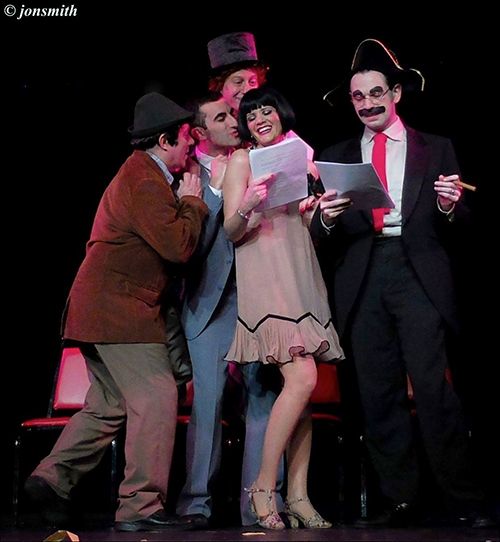by Samuel L. Leiter
Film buffs, especially those who know the 1942 movie classic Casablanca and something of its backstory, will get a kick out of Casablancabox, Sara Farrington’s decidedly clever and ambitious multimedia piece, wonderfully staged by her husband, Reid Farrington. Those who aren’t film buffs and know little or nothing of Casablanca will appreciate CasablancaBox’s theatrics but have little idea of what the fuss is all about.
Casablanca’s heartbreakingly romantic, politically-tinged tale takes place in the title’s Vichy-controlled, Moroccan city, at Rick’s Café Americain. There, Rick Blaine, the cynical American expatriate, encounters his former lover, the beautiful Ilse Lund, and her husband, Laszlo, a Czech resistance fighter. Around them swarms a nest of intrigue involving Nazis, corrupt Vichy officials, and various people, shady and otherwise, seeking to flee the oncoming conflagration. What goes around, comes around.
Directed by Hungarian Michael Curtiz, Warner Brothers’ Casablanca’s unforgettable cast of international actors was led by Humphrey Bogart and Swedish Ingrid Bergman as the ill-fated lovers, and Austrian Paul Henreid as Laszlo. Ugarte, a minor criminal, and Major Strasser, a Gestapo officer, were played by Austro-Hungarian Peter Lorre and German Conrad Veidt, while two Brits, Sidney Greenstreet and Claude Rains, acted the crooked Signor Ferrari and the corrupt French official, Capitaine Louis Renault. African-American Dooley Wilson was Sam, the entertainer who sings “As Time Goes By,” now Warner Brothers’ theme song.
All these people, and others, appear in this intriguing attempt to tell the story of Casablanca’s production and of how the lives of its actors intersected with those of their characters. An ensemble of 16, many covering more than one role, is ordered about by the frazzled Curtiz (Kevin R. Free); at his side is his able assistant, Irene (Stephanie Regina), who also does spot-on, 40s-style, voiceovers.
We see not only the shooting of the scenes but listen in on the actors’ chatter and observe their private moments. Much of this is done in fast-paced sequences as actors manipulate mattress-sized, linen-covered frameworks to serve as projection screens, or carry picture frame-sized screens, on which movie clips are shown. The screens are held up before the actors, who can be seen through the projections. Sometimes we hear the actors while the movie voices are muted, and sometimes the opposite occurs. When the camera positions switch, the actors rapidly shift their own.
Director Farrington, who also designed the sound stage-like set and created the complex video design, does masterful work, especially as the screens always seem to be on the move. (It’s not clear where Laura K. Nicholl’s choreography begins and Farrington’s staging leaves off.) Even those who’ve never seen Casablanca will appreciate the expertise.
Multiple thematic threads appear, including the complexities of illusion vs. reality, the studio system, censorship, refugees, racism, and the like, but the chief goal is to tell the well-documented backstage stories associated with the movie. As placed in the script, however, many seem clumsy and over-obvious; what works best is when we see how the film was written by its four writers on the fly, with multiple endings being tried.
There’s considerable irony in the fact that the actors, especially Bergman (Catherine Gowl), have little confidence in the project. Their private lives—including Lorre’s (Rob Hille) morphine addiction, Bergman’s affair with Roberto Rossellini (Zac Hoogendyk), Wilson’s (Toussaint Jeanlouis) unfair contract, and Bogart’s problems with his alcoholic wife, Mayo Methot (Erin Treadway)—get a bit too much attention. Mayo, in a particularly nonessential scene, even auditions for a movie by singing “Moaning Low” in the amateurish way Claire Trevor sings it in Key Largo.
Lots of trivia about the making of the film is stuffed into the plot but so is surprisingly inaccurate information, particularly all the material about secondary actor Gregory Gaye (Gabriel Diego Hernandez) being Austrian when, in fact, he was Russian and never did what the script describes; Lukas’s backstory is similarly false, and one could cite other misinformation of the kind that will rile aficionados.
CasablancaBox makes it clear that it doesn’t intend for its actors to compete with their originals, even casting against type, such as having a trim actor (Kyle Stockburger) play the obese Greenstreet or African-Americans play Bogart (Roger Casey) and Curtiz. No one has an authentic accent and only Casey attempts to sound anything like who he’s playing. Still, it’s impossible to ignore the disconnect between the actors and their avatars, who are up there in black and white. Standouts are Catherine Gowl, who, while nothing like Bergman, has a basic sincerity, and Stephanie Regina, who, not having to represent a famous star, comes off best.
Cavils aside, CasablancaBox is compellingly creative. Only 90 minutes long, it gives those who don’t know the movie time to catch it On Demand for $2.99. Which is one way to know what all the fuss is about.
Photos: Benjamin Heller
CasablancaBox
HERE Arts Center
145 Avenue of the Americas, NYC
Through April 29

























